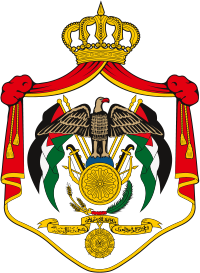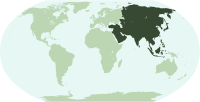- Coat of arms of Jordan
-
Coat of arms of the Hashemite Kingdom of Jordan 
Details Armiger Hashemite Kingdom of Jordan Adopted 1921 Crest An Eagle proper displayed Torse A Blue Globe Escutcheon A bronze shield Supporters Two Flags of Jordan, spears, swords, bows and arrows Compartment A three branches of wheat to the left and a palm branch to the right. The highest Jordanian medal stretching down from between the wheat and palm branches and a yellow cordon hanging from the ribbon of the decorative order of al-Nahda consisting of three parts on which the following phrases are embroidered Motto Left: “Who seeks support and guidance from God.” Middle: “King of the Hashemite Kingdom of Jordan” Right: “Abdullah II bin Al Hussein bin Aoun” Orders falcon Other elements A Coat of Arms is placed on a Scarlet coat with a white inner background lined with a sash and topped with a crown On August 25, 1934, the Executive Council (The Council of Ministers at the time) issued Directive No. 558 declaring the Coat of Arms (Arabic: شعار المملكة الأردنية الهاشمية), (which was designed in 1921 upon the request of His Highness Prince Abdullah I) as the official emblem of the country and outlining its specific design layout. On February 21, 1982, the Council of Ministers issued the official Notification No. 6, which gave written specifications and explanations of the official emblem of the country. The following description is:
- The crown symbolizes the system of monarchy.
- The sash upon which the crown is placed symbolizes the Hashemite throne. Its scarlet color represents sacrifice, while the white inner background symbolizes purity.
- The two flags are the flags of the Great Arab Revolt.
- The eagle in the center of the coat of arms symbolizes power, might and loftiness. The eagle is perched on the globe, and his wings touch the two flags of the Great Arab Revolt.
- a - The blue color of the globe symbolizes the spread of Islam across the world.
- b - The bronze shield in front of the globe represents the defense of truth and right in the world.
- The spears, swords, bows and arrows are traditional Arab weapons.
- Below the shield to the left are three branches of wheat, and to the right is a palm branch.
- Stretching down from between the wheat and palm branches is the highest Jordanian medal, the decorative order of al-Nahda.
- A yellow cordon hanging from the ribbon of the decorative order of al-Nahda consisting of three parts on which the following phrases are embroidered:
- On the right: “Abdullah II bin Al Hussein bin Aoun”
- (Aoun, the great grandfather of Al Sharif Al Hussein bin Ali)
- In the middle:
- “King of the Hashemite Kingdom of Jordan”
- On the left:
- “Who seeks support and guidance from God.”
External links
- Description from King Hussein's website
- King Abdullah II website. Description can be found at "About Jordan" → "The Jordanian Coat of Arms".
- Description from Embassy of Jordan in Washington
National emblems and coats of arms of Asia Sovereign
states- Afghanistan
- Armenia
- Azerbaijan
- Bahrain
- Bangladesh
- Bhutan
- Brunei
- Burma (Myanmar)
- Cambodia
- People's Republic of China
- Cyprus
- East Timor (Timor-Leste)
- Egypt
- Georgia
- India
- Indonesia
- Iran
- Iraq
- Israel
- Japan
- Jordan
- Kazakhstan
- North Korea
- South Korea
- Kuwait
- Kyrgyzstan
- Laos
- Lebanon
- Malaysia
- Maldives
- Mongolia
- Nepal
- Oman
- Pakistan
- Philippines
- Qatar
- Russia
- Saudi Arabia
- Singapore
- Sri Lanka
- Syria
- Tajikistan
- Thailand
- Turkey
- Turkmenistan
- United Arab Emirates
- Uzbekistan
- Vietnam
- Yemen

States with limited
recognition- Abkhazia
- Nagorno-Karabakh
- Northern Cyprus
- Palestine
- Republic of China (Taiwan)
- South Ossetia
Dependencies and
other territoriesCategories:- National symbols of Jordan
- National coats of arms
Wikimedia Foundation. 2010.
